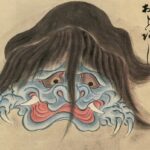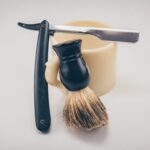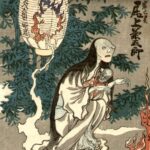Are you a fan of horror stories? Have you ever delved into the lore of the kappa, the mystical aquatic creatures from Japanese folklore? Interestingly, these beings possess an unusual weakness that renders them harmless.
Join us in this post as we uncover everything about the origins, characteristics, and legends surrounding them. Keep reading if you dare!

What are Kappa?
They are legendary creatures deeply rooted in Japanese mythology, believed to inhabit rivers and lakes. Their name originates from the words ‘kawa’ (meaning river) and ‘wappa’ (meaning child), translating to “river child”.
These beings resemble small humanoids about the size of a child, sporting turtle-like faces, scaly skin with a shell on their backs, and a beak-shaped mouth. Their most defining trait is a water-filled hollow atop their heads, which is said to be the source of their power and vitality.
Apart from their distinct physical appearance, kappa possess unique adaptations enabling them to swim at remarkable speeds. This includes webbed interdigital membranes on their feet and hands. Some depictions also illustrate them with connected arms across the torso, facilitating effortless lateral movement in the water.

Legends and beliefs
These creatures are especially known for their mischievous nature, often playing pranks on humans, yet they can also pose a significant threat. Legend suggests they have a penchant for feeding on the blood and liver of individuals near water bodies, purportedly extracting a magical ball called the shirikodama, which is sometimes associated with the anus, potentially referring to the prostate.
Also, certain Japanese villages continue the tradition of using fireworks annually to ward off malevolent spirits, including kappa.
However, these creatures possess a peculiar vulnerability: the water-filled hollow on their heads. Should it spill or dry up, kappa lose their powers, becoming docile. Hence, encountering one might call for a respectful bow. It’s believed that if a person bows, the kappa, out of courtesy, will reciprocate, bowing its head and inadvertently spilling the water. This act allows for an escape or a chance to negotiate.
Despite their mischievous and dangerous tendencies, kappa are considered highly intelligent beings. They hold knowledge of medicine and martial arts and take delight in activities such as sumo wrestling, shogi (similar to chess), and cucumbers, which are their favorite food. Legend has it that offering a cucumber with a person’s name carved onto it might lead to the kappa befriending that individual, granting wishes, or imparting martial arts wisdom.
While traditional tales often portray kappa as adversaries, there’s a belief that they can establish a rapport with and help humans if they perceive a benefit in return.

Origins
While various legends try to explain their existence, the origins of the Kappa remain uncertain.
One such legend suggests that kappa are descendants of a dragon couple that resided at the sea’s depths but were expelled by the deity Ryujin due to their misdeeds.
Another belief suggests that kappa are the spirits of children who met a tragic fate by drowning or being cast into the water by their own parents.
A third tale proposes that kappa are remnants of an ancient humanoid reptilian race that sought refuge in water following the arrival of humans.
Regardless of their precise origin, these creatures stand as integral figures within Japan’s diverse mythology, symbolizing the profound connection between the Japanese people and the natural world. They serve as a testament to how water embodies both life and death, how the unknown can simultaneously captivate and terrify, and how differences can shape perceptions of friendship or hostility. The kappa lore epitomizes these nuanced relationships within Japanese culture and folklore.

However, the kappa hold dual roles in Japanese belief systems: revered as water deities in Shinto and regarded as voracious ogres in Japanese Buddhism. With over eighty distinctive names across regions and local folklore, some common names for these beings include kawappa, gawappa, kōgo, mizushi, mizuchi, enkō, kawaso, suitengu, and dangame.
These entities stand as one of the most prominent yōkai (supernatural creatures) depicted in Japanese culture, featuring prominently in various art forms and literature, showcasing their enduring popularity and significance within Japanese folklore and storytelling traditions.
Kappa in today’s Japanese culture
The Kappabuchi River, situated in Tōno, Iwate Prefecture, is renowned as a notable dwelling place for kappa. Within this locale at the Jōkenji Buddhist temple, a statue of a komainu dog stands in homage to the kappa. Legend has it that the kappa assisted in extinguishing a fire that threatened the temple.
Moreover, in Tokyo’s Asakusa district, the Sogenji Buddhist temple reveres the kappa. Tradition holds that a mummified arm attributed to a kappa is enshrined within the chapel hall, signifying the veneration and cultural significance attached to these mythical creatures.
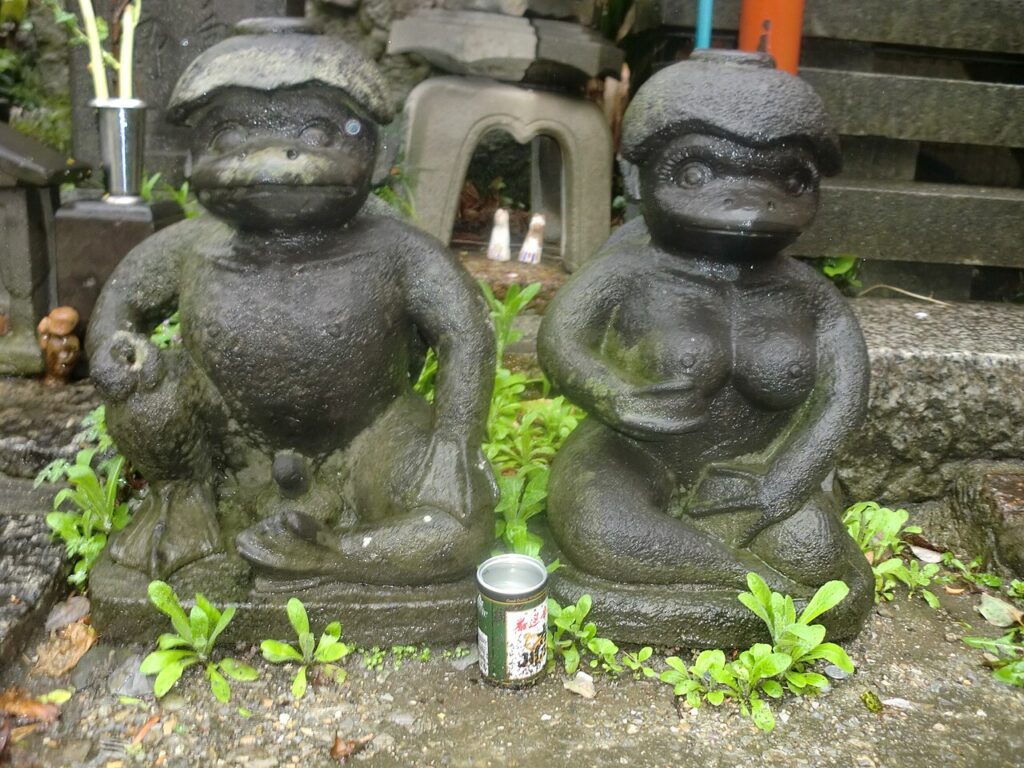
Today, kappa remain a significant aspect of Japanese culture, evident in various artistic and literary depictions that encapsulate their essence and symbolism. Over time, their portrayal has shifted from menacing beings to comical and charming characters, reflecting diverse forms of cultural expression.
These mythical creatures have served as inspiration for a multitude of artworks, literature, films, and animations. Examples range from classical paintings to contemporary manga and anime. Notably, in the Yo-kai Watch video game series, kappa feature prominently as main characters. Additionally, the renowned film Spirited Away draws upon mythology, showcasing their enduring influence on Japanese popular culture and storytelling.

In literature, kappa are recurring figures in tales and legends, spanning traditional and contemporary narratives. These stories delve into various aspects of kappa lore, highlighting their mischievous nature, aquatic prowess, and their peculiar interactions with humans. Portrayed as captivating and mysterious entities, kappa bring an element of intrigue and fantasy to these narratives.
However, alongside their enigmatic portrayal, they are also utilized by parents as cautionary figures, warning children about potential dangers concealed within rivers and lakes. These cautionary tales often depict kappa attempting to entice individuals into the water, emphasizing the peril of drowning as a moral lesson for young audiences.
Kappa in Japanese cuisine
Kappa has made an impact on Japanese cuisine, notably seen in a well-known dish called kappamaki. This sushi roll features cucumber as its primary filling. The dish acquired its name from the legend surrounding kappa’s fondness for cucumbers, as folklore suggests they frequently pilfer this vegetable from orchards.
Kappamaki has garnered popularity and is readily available in numerous sushi restaurants across Japan. Additionally, cucumbers were abundant and affordable in Japan, making them an ideal ingredient that harmonizes well with rice and nori seaweed, contributing to the dish’s widespread appeal and success.

Beyond kappamaki, culinary nods to kappa extend to desserts, sweets, and beverages inspired by their imagery and legends. These creations serve as a tribute, honoring and celebrating the presence of these creatures within Japanese culture while offering diverse culinary experiences to enthusiasts.
Kappa-related festivals and traditions
Kappa take center stage in various festivals and traditions across Japan. These events, dedicated to these mythical creatures, span different regions and encompass theatrical performances, vibrant parades, and engaging interactive activities.
These festivals offer a platform for visitors to delve into kappa folklore, immerse themselves in traditional culture, and celebrate the captivating history surrounding these entities.
For instance, in Chiba Prefecture, the annual Abiko Kappa Matsuri features a parade showcasing floats adorned with kappa figures. Fukushima Prefecture hosts the Kappa Buchi Mawashi, a swimming competition where participants don caps resembling kappa heads. Meanwhile, Tottori Prefecture boasts Kappa no Kuni, a theme park exclusively dedicated to these mythical creatures.
Additionally, statues, temples, shrines, and offerings paying homage to these fantastical beings can be found in various parts of the country, serving as testaments to their cultural significance in Japan.
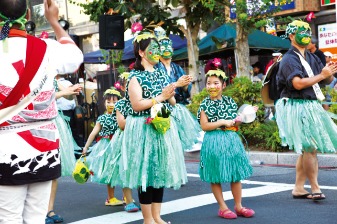
What is more, apart from dedicated festivals, these mythical entities are also incorporated into various other Japanese festivities and traditions. During the Obon festival in summer, a time when it’s believed that ancestral spirits revisit the earthly realm, kappa are regarded as guardians aiding in guiding these spirits back to the water. This belief is commemorated through diverse rituals and dances that involve and honor the presence of kappa within the festival’s customs.
Other notable yokai in Japanese mythology
- Otoroshi: A fearsome and hairy spirit known for guarding sacred locations or shrines.
- Rokurokubi: Beings possessing the supernatural ability to elongate their necks.
- Tengu: Beings with both bird and human characteristics, often associated with war and wind manipulation.
- Tanuki: Fox spirits that take on the appearance of raccoons, associated with luck and transformation.
- Kitsune: Legendary foxes known for their intelligence, cunning, shapeshifting abilities, and blessings.
- Hebi: Magical snakes with the ability to transform into humans, believed to possess healing powers.
- Mujina: Shapeshifting creatures with the capability to take on various forms, often resembling raccoons.
- Bakeneko and Nekomata: Supernatural cats with shapeshifting abilities and mystical powers.
- Oni: Powerful demons depicted as monstrous figures with horns, red or blue skin, and associated with mischief.
- Tsukumogami: Inanimate objects that come to life after a certain age, believed to possess supernatural powers.

